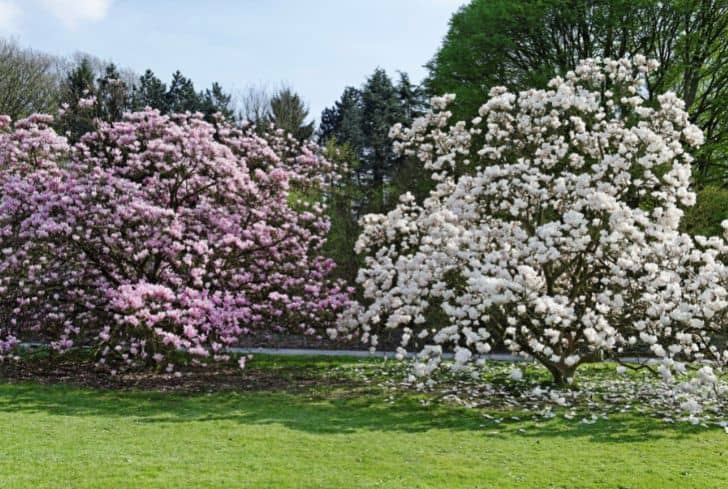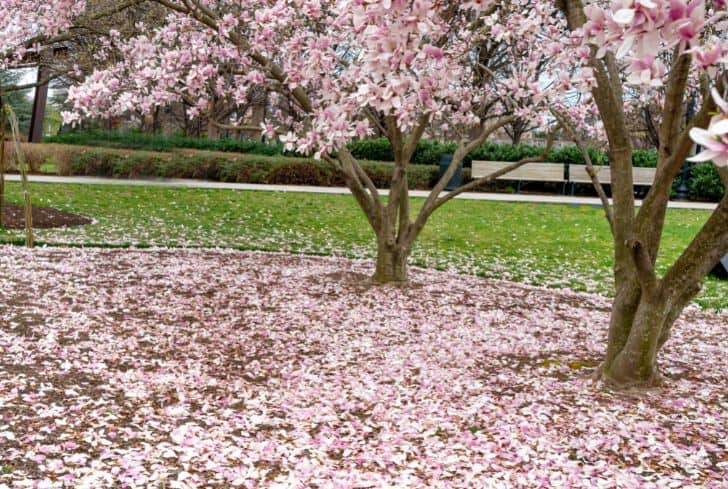The magnolia tree is one of the most intriguing specimen plants you can have in your landscape. The tree is highly valued for its large, fragrant, flowers. Magnolia trees always look beautiful, but with those lovely flowers in their bloom, they are incredibly gorgeous.
This is why most growers of this showy tree are very excited about its bloom time and it can be very annoying when your magnolia doesn’t bloom. Magnolia trees are known to bloom every year once they are mature and have ideal growing conditions. Magnolia can be grown in almost all regions of the United States. However, the bloom time of Magnolia varies across regions and varieties.
In this article, we’ll be discussing magnolia bloom time, particularly in areas like Florida, Texas, and North Carolina, and the several reasons why your magnolia tree isn’t flowering. We’ve also created a guide on how to keep your magnolias blooming and extend the lifespan of your magnolia tree.
When do Magnolia Trees Bloom in Florida?
Typically, Magnolias bloom from May to June (early-mid summer) in this region. Florida has a perfect climate for most species of magnolia to grow and bloom abundantly, hence, magnolia is popularly grown and highly valued in Florida.
Native to this region include the famous Southern Magnolia (Magnolia Grandiflora) and Sweetbay magnolia (Magnolia Virginiana). These species do well in Florida and are widely grown in the region. Specifically, the southern magnolia variety ‘Little Gem’ is the best type for the average suburban yard in Florida and it blooms at a young age from late spring through summer.
When do Magnolia Trees Bloom in Texas?
Most magnolia trees bloom in Texas from February to April (early spring). The warm temperature and mild winter in this region present an ideal environment for the growth of this tree. Most varieties of magnolia don’t have problems establishing and thriving in Texas.
However, one of the species you would find in abundance in Texas is the Star Magnolia (Magnolia stellate) alongside the iconic Southern Magnolia (Magnolia Grandiflora). The small-sized star magnolia makes an excellent sidewalk tree, it’s a perfect option for small spaces.
When do Magnolia Trees Bloom in North Carolina?
Whenever you see magnolia flowers emerge in North Carolina, you can be certain that it’s summer already. Magnolia trees bloom in North Carolina around May and June with the likes of Little Gem flowering sporadically throughout summer and even into fall.
Little Gem is popularly grown in this region and Sweetbay magnolia (Magnolia Virginiana) is also native to this region. The area provides enough warmth for magnolia’s growth and flowering.
Do all Magnolia Trees Bloom?
All magnolia trees bloom, however some magnolia trees bloom more than others due to certain key factors. These factors can even prevent magnolia from blooming.
For instance, magnolia planted in a very cold climate might not bloom because flower buds are very sensitive to cold. While some varieties bloom only once yearly, others such as the Saucer Magnolia (Magnolia x soulangeana) variety bloom twice yearly (first in early spring and second in late summer.)
Aside from climate and variety, other factors including age, plant health, lighting, and growing conditions significantly influence the blooming of magnolia trees. If your magnolia tree is not flowering, we’ve created a guide below to help you find out what you’re not doing right.
Why Isn’t my Magnolia Tree Flowering?
Here are the major reasons why your magnolia tree isn’t flowering:
Age
Age is the very first thing you should consider if your magnolia isn’t flowering. Magnolia trees only flower when they are mature enough, flowering requires a lot of plant energy and only mature plants have the required strength.
Plus, the age of flowering differs across magnolia varieties. Most magnolia species begin to flower once they are ten years, some species bloom as early as three years, while others take up to 20-25 years.
Unsuitable climate
If you’re certain that your magnolia tree has reached the age of blooming and it just doesn’t flower, then your first step should be to check the hardiness zone of your magnolia species. This would tell you if your species can thrive in your area. If you’ve planted a magnolia species in an unsuitable climate, that may be the reason why it isn’t blooming.
A warm-climate species such as Southern Magnolia (Magnolia Grandiflora) thrives in USDA zones 7 through 9. If Southern Magnolia is planted in a cold climate, it’ll likely not flower. But a hardy species like Saucer Magnolia (Magnolia x soulangeana) can thrive in USDA zones 4 through 9 as it prefers a cool climate.
Inadequate lighting
If you’ve planted your magnolia tree in a suitable climate, then you should check to make sure it is getting sufficient lighting. Inadequate lighting is another major reason for the lack of flowers on magnolia trees.
Magnolia will survive in light shade, but it grows and flowers best in full sun. If you’ve planted this tree in a fully-shaded area that leaves it with little or no lighting, you’re preventing it from growing and flowering.
Root damage
Another thing that can influence magnolia’s blooming is root damage. Damage to the plant roots can be a result of transplanting, digging around the root area, and diseases such as root rot. The plant roots ensure the uptake of nutrients and water from the soil, promoting growth and flowering.
If you’ve recently transplanted your mature magnolia tree, it’ll likely not bloom since it’s only beginning to establish its roots. Any form of damage to the roots will slow down growth and flowering.

Unsuitable soil condition
Most magnolia species need to be in rich, acidic, well-drained soil to grow and bloom abundantly. The ideal soil PH level for this tree is between 5.0 and 6.5, anything less or more may prevent it from blooming.
If you also notice other symptoms such as discoloration of the leaves and stunted growth, you’ll want to get your soil checked. If your soil’s pH level is not suitable for magnolia, you’ll need to amend it accordingly.
Over Fertilizing
Overfertilizing can also affect magnolia’s flowering process. Fertilizers mainly contain nutrients such as nitrogen, phosphorus, and potassium. Nitrogen promotes leaf and shoots growth, while phosphorus increases flowering and root strength.
Overly feeding your magnolia tree with fertilizers that are rich in nitrogen will make the plant’s channel energy to leaf production instead of flowering. You’d want to go for fertilizers rich in phosphorus and other nutrients your soil lacked during the soil test.
How Long do Magnolia Blooms Last?
Generally, Magnolia’s bloom lasts for about two to three weeks. The flowers usually emerge and stay on the plant for two weeks before falling off. The leaves do not immediately emerge into the daylight after blooming, so the white to pink flowers are more noticeable and shiny.
Several species of magnolia trees have different blooming periods, there are early and late bloomers. Some deciduous magnolia such as the Star Magnolia blooms from late March through the end of April while the evergreens like Southern and Sweetbay bloom around May/June.
Some of the first species to bloom are the white flowers of the star magnolia (Magnolia Stellaria), followed by the tulip magnolias (Magnolia x soulangeana) and purple magnolias (Magnolia liliiflora).
How do You Keep Magnolias Blooming?
To keep your magnolia tree blooming for a longer period, take care of it using the tips below:
- Inadequate watering will cause the flowers to drop early. Ensure you water magnolia adequately especially in the summer heat and during its bloom even if it is fully established. A deep watering 2-3 times weekly is preferable for this tree.
- If a late frost occurs, it can damage magnolia flower buds even before they start to open up, so you want to protect your plant from the cold and harsh winds by adding mulch to the topsoil. If you’ve planted a small-sized variety, covering your plant with burlap is an amazing option.
- If you live in regions where late frosts are very common, you should consider planting late-blooming magnolia species.
- As much as possible, keep foot traffic away from the root zones of these trees as the roots are sensitive and can easily get damaged.
- Never prune your tree during the growing season. For the best result, only prune magnolia trees to remove dead leaves and branches after the last bloom to improve their appearance and growth.
How Long do Magnolia Trees Live?
On average, the lifespan of magnolia trees is between 80 and 100 years. With proper care and maintenance, some magnolia trees can even live up to 120 years. The lifespan of a magnolia tree depends on numerous factors including the planting area, exposure to wind, sunlight, etc.
Magnolia trees in the wild tend to live longer than those planted in the cities due to harsh factors like pollution, rocky soil, concrete around the growing area, and insufficient lighting. To extend the lifespan of your tree, ensure it sits in suitable, well-drained, moist soil.
Give the tree enough space to grow to its maximum height of about 80 feet tall and about 40 feet in diameter. Also, provide sufficient water and lighting to keep your magnolia tree healthy.






